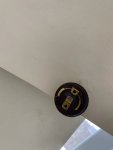Fred B
Senior Member
- Location
- Upstate, NY
- Occupation
- Electrician
Customer handed me a hanging light fixture they wanted installed, thought something was off when I saw a brown and blue conductor in the cord. Saw what looked at first to be a standard medium Edison base. But on further looking the bulb was a little different and marked 230V 60W. Can't seem to find any direct information reference on this bulb. What is this? Can the socket be changed out to work on a 120V circuit? The existing base is slightly different, standard bulb will scew in but won't make center pin contact on a 120V bulb. They got the fixture for the appearance, it is unique so they'll want to have it work.



